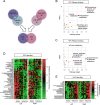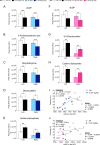Prophylactic ketamine alters nucleotide and neurotransmitter metabolism in brain and plasma following stress
- PMID: 29599484
- PMCID: PMC6046049
- DOI: 10.1038/s41386-018-0043-7
Prophylactic ketamine alters nucleotide and neurotransmitter metabolism in brain and plasma following stress
Abstract
Recently, we have shown that ketamine given prior to stress exposure protects against the development of depressive-like behavior in mice. These data suggest that it may be possible to prevent the induction of affective disorders before they develop by administering prophylactic pharmaceuticals, a relatively nascent and unexplored strategy for psychiatry. Here, we performed metabolomics analysis of brain and plasma following prophylactic ketamine treatment in order to identify markers of stress resilience enhancement. We administered prophylactic ketamine in mice to buffer against fear expression. Following behavioral analyses, untargeted metabolomic profiling was performed on both hemispheres of the prefrontal cortex (PFC) and the hippocampus (HPC), and plasma. We found that prophylactic ketamine attenuated learned fear. Eight metabolites were changed in the PFC and HPC upon ketamine treatment. Purine and pyrimidine metabolism were most significantly changed in the HPC, PFC, and, interestingly, plasma of mice two weeks after prophylactic administration. Moreover, most precursors to inhibitory neurotransmitters were increased whereas precursors to excitatory neurotransmitters were decreased. Strikingly, these long-term metabolomic changes were not observed when no stressor was administered. Our results suggest that prophylactic treatment differentially affects purine and pyrimidine metabolism and neurotransmission in brain and plasma following stress, which may underlie the long-lasting resilience to stress induced by a single injection of ketamine. These data may provide novel targets for prophylactic development, and indicate an interaction effect of prophylactic ketamine and stress. To our knowledge, this is the first study that identifies metabolomic alterations and biomarker candidates for prophylactic ketamine efficacy in mice.
Conflict of interest statement
AM and CTL reported no biomedical financial interests or potential conflicts of interests. CH, AK, NRN, and MAK are employees of BERG LLC and own stock. NRN is a founder of BERG. JCM, RAB, and CAD are named on non-provisional patent applications for the prophylactic use of ketamine against stress-related psychiatric disorders.
Figures





Similar articles
-
Ventral CA3 Activation Mediates Prophylactic Ketamine Efficacy Against Stress-Induced Depressive-like Behavior.Biol Psychiatry. 2018 Dec 1;84(11):846-856. doi: 10.1016/j.biopsych.2018.02.011. Epub 2018 Feb 23. Biol Psychiatry. 2018. PMID: 29615190 Free PMC article.
-
Prophylactic (R,S)-ketamine selectively protects against inflammatory stressors.Behav Brain Res. 2020 Jan 27;378:112238. doi: 10.1016/j.bbr.2019.112238. Epub 2019 Sep 26. Behav Brain Res. 2020. PMID: 31563463
-
Prophylactic Ketamine Attenuates Learned Fear.Neuropsychopharmacology. 2017 Jul;42(8):1577-1589. doi: 10.1038/npp.2017.19. Epub 2017 Jan 27. Neuropsychopharmacology. 2017. PMID: 28128336 Free PMC article.
-
Ketamine as a prophylactic resilience-enhancing agent.Front Psychiatry. 2022 Jul 28;13:833259. doi: 10.3389/fpsyt.2022.833259. eCollection 2022. Front Psychiatry. 2022. PMID: 35966469 Free PMC article. Review.
-
Weapons of stress reduction: (R,S)-ketamine and its metabolites as prophylactics for the prevention of stress-induced psychiatric disorders.Neuropharmacology. 2023 Feb 15;224:109345. doi: 10.1016/j.neuropharm.2022.109345. Epub 2022 Nov 23. Neuropharmacology. 2023. PMID: 36427554 Review.
Cited by
-
Prophylactic efficacy of 5-HT4R agonists against stress.Neuropsychopharmacology. 2020 Feb;45(3):542-552. doi: 10.1038/s41386-019-0540-3. Epub 2019 Oct 10. Neuropsychopharmacology. 2020. PMID: 31600767 Free PMC article.
-
Traumatic Brain Injury-Induced Fear Generalization in Mice Involves Hippocampal Memory Trace Dysfunction and Is Alleviated by (R,S)-Ketamine.Biol Psychiatry. 2024 Jan 1;95(1):15-26. doi: 10.1016/j.biopsych.2023.06.030. Epub 2023 Jul 8. Biol Psychiatry. 2024. PMID: 37423591 Free PMC article.
-
Transcriptional signatures of early-life stress and antidepressant treatment efficacy.Proc Natl Acad Sci U S A. 2023 Dec 5;120(49):e2305776120. doi: 10.1073/pnas.2305776120. Epub 2023 Nov 27. Proc Natl Acad Sci U S A. 2023. PMID: 38011563 Free PMC article.
-
Prefrontal cortex circuits in depression and anxiety: contribution of discrete neuronal populations and target regions.Mol Psychiatry. 2020 Nov;25(11):2742-2758. doi: 10.1038/s41380-020-0685-9. Epub 2020 Feb 21. Mol Psychiatry. 2020. PMID: 32086434 Free PMC article. Review.
-
Ketamine for Depression: Advances in Clinical Treatment, Rapid Antidepressant Mechanisms of Action, and a Contrast with Serotonergic Psychedelics.Curr Top Behav Neurosci. 2022;56:141-167. doi: 10.1007/7854_2022_313. Curr Top Behav Neurosci. 2022. PMID: 35312993 Free PMC article.
References
Publication types
MeSH terms
Substances
Grants and funding
LinkOut - more resources
Full Text Sources
Other Literature Sources
Medical
Miscellaneous

